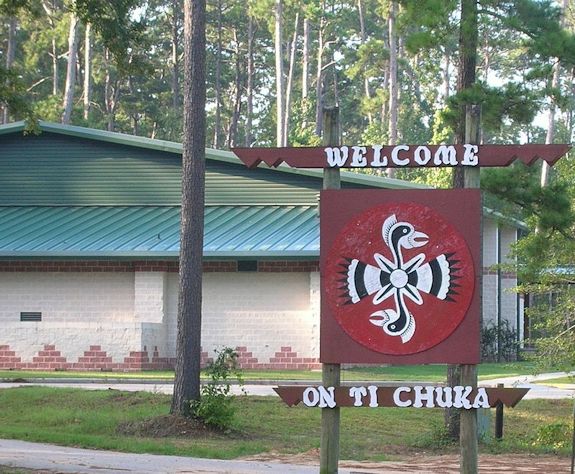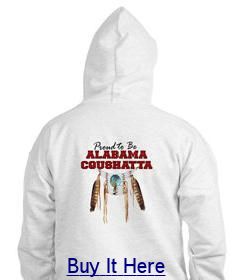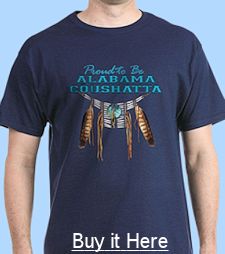Home :: US Tribes A to Z :: US Tribes A-B :: Alabama-Coushatta Tribe of Texas
Who are the Alabama-Coushatta Tribe?
The Alabama and Coushatta formed an inter-tribal friendship shortly after each tribe migrated into Texas. In the early 1800s, their original homelands were taken over by white settlers.
Sam Houston recommended that the state purchase 1,280 acres for the Alabamas and set aside 640 acres for the Coushattas.
The land for the Coushattas never materialized, so either through marriage or special permission, the Coushatta came to live on the allotted lands of the Alabamas – uniting the two to become the Alabama-Coushatta.

Alabama-Coushatta Tribe of Texas entrance sign By ishwar via Wikamedia Commons
Official Tribal Name: Alabama-Coushatta Tribe of Texas
Address: 571 State Park Rd 56, Livingston, TX 77351
Phone: (936) 563-1100
Email: information@actribe.org
Official Website: www.alabama-coushatta.com/
Recognition Status: Federal Recognition
The Alabama-Coushatta Tribe of Texas was officially federally recognized as a sovereign tribe by the federal government in 1937. This recognition acknowledges the tribe’s political autonomy and provides access to various federal programs and services.
Traditional Name / Traditional Meaning:
Alibamu – Means “cleared thicket” or “vegetation gatherers”
Koasati – Means “white cane”
Common Name: Alabama-Coushatta
Meaning of Common Name: Alabama – Means “cleared thicket” Coushatta – Means “white cane”
Alternate names: Albaamaha, formerly Alabama-Coushatta Tribes of Texas
Region: Southeast Region
State(s) Today: Texas
Traditional Territory:
 The Alabamas were once part of the Moundville chiefdom located in western Alabama and eastern Mississippi, and the Coushattas were connected with the Coste chiefdom, located near Bussell Island in present-day eastern Tennessee.
The Alabamas were once part of the Moundville chiefdom located in western Alabama and eastern Mississippi, and the Coushattas were connected with the Coste chiefdom, located near Bussell Island in present-day eastern Tennessee.
During the 19th century, both tribes moved to Western Louisiana and Eastern Texas.
Confederacy: Muscogee Creek Confederacy
Treaties:
Reservation: Alabama-Coushatta Reservation
The Alabama share the Alabama-Coushatta Indian Reservation in Texas with the Coushatta, who also speak a Muskogean language.
Land Area: ,280 acres (5 km2)
Tribal Headquarters: Livingston, Texas
Government:
The Alabama-Coushatta Tribe of Texas operates under a tribal government structure. The government consists of elected officials, including a tribal council or committee, which oversees the administration of tribal affairs and the implementation of tribal policies. The council is responsible for making decisions related to the welfare and development of the tribe.
Charter:
Name of Governing Body: Tribal Council
Number of Council members: The Alabama-Coushatta Tribal Council consists of a total of seven members.
Dates of Constitutional amendments:
Number of Executive Officers: The number of executive officers within the Alabama-Coushatta Tribe of Texas may vary. However, typically, there are positions such as a tribal chairman, vice-chairman, secretary, treasurer, and other executive roles that are responsible for overseeing the day-to-day operations of the tribal government.
Elections:
Elections for the Alabama-Coushatta Tribal Council and executive officers are typically held at regular intervals, as determined by the tribal constitution and applicable laws. The specific frequency and procedures for elections may vary and are determined by the tribe’s governing body.
Population at Contact:
Registered Population Today:
In 1990, there were more than 1,000 Alabama and Coushatta, combined.
Genealogy Resources:
Black Creeks adopted through the Dawes Commission between 1898 and 1916
Tribal Enrollment Requirements:
Language Classification: Hokan-Siouan >> Muskogean >> Apalachee-Alabama-Koasati
Language Dialects: Alabama and Koasati, which are mutually intelligible
Number of fluent Speakers:
Dictionary:
Origins:
 Similar origin myths indicate these two tribes were connected long before encroachment by Europeans. The origin myths of both tribes focus on the interconnectedness of the tribes.
Similar origin myths indicate these two tribes were connected long before encroachment by Europeans. The origin myths of both tribes focus on the interconnectedness of the tribes.
One myth states that the two tribes sprouted from either side of a cypress tree. According to their tribal folklore, the ancestors of the two groups traveled from deep beneath the Earth before reaching the surface. After much time had passed, they surfaced at the opposite ends of the tree’s roots, and once they saw the light of day, their ancestors discovered the great Alabama River. The emerging Alabamas and Coushattas established their villages in two separate bodies but often hunted together and eventually began to intermarry.
Another legend was recorded in 1857 from Se-ko-pe-chi, one of the oldest Creeks in Indian Territory. He said that the Alibamu and Koasati tribes “sprang out of the ground between the Cohawba and Alabama Rivers.”
Bands, Gens, and Clans
The Alabama-Coushatta Tribe of Texas is composed of two distinct groups: the Alabama and the Coushatta. Historically, they were separate tribes with their own bands, gens (also known as clans), and social structures. Each band or clan had its own leadership and played a vital role in the social and political organization of the tribe.
Social Organization:
Related Tribes:
- Alabama-Coushatta Tribe (Texas) (F)
- Alabama-Quassarte Tribal Town (Oklahoma) (F)
- Alibamu Indians
- Chattahoochee Creeks
- Cher-O-Creek Intra Tribal Indians (S)
- Coushatta Tribe of Louisiana (Louisiana)
- Creek Freedmen
- Kialegee Tribal Town (Oklahoma) (F)
- Lower Muskogee Creek Tribe (East of the Mississippi) (S)
- Machis Lower Creek Indian Tribe (Alabama) (S)
- Mississippian Moundbuilders
- Muscogee (Creek) Nation (Oklahoma) (F)
- Ochese Creeks
- Poarch Band of Creek Indians of Alabama (F)
- Star Clan of Muscogee Creeks (Alabama) (S)
- Thlopthlocco Tribal Town (F)
- Also see Creek Tribes
Traditional Allies:
The Alabama-Coushatta Tribe of Texas had various alliances and relationships with neighboring tribes and groups. Some of their traditional allies included the Caddo, Choctaw, and Cherokee. These alliances often served as a means of mutual defense, trade, and cultural exchange.
Traditional Enemies: Chickasaw, and at various times, the Choctaw, and Cherokee.
Ceremonies / Dances:
Ceremonial dances held a significant place in the cultural and spiritual life of the Alabama-Coushatta people. These dances were performed for various occasions, including religious ceremonies, harvest celebrations, and social gatherings.
Each dance had its specific meaning and purpose, often tied to tribal mythology, historical events, or the natural world. Traditional dances incorporated intricate footwork, gestures, drumming, and singing. They served as a way to connect with ancestral spirits, seek blessings, and connect socially.
Modern Day Events & Tourism:
The Alabama-Coushatta Tribe of Texas has a rich cultural heritage that is rooted in their historical connection to the Southeastern United States.
The tribe actively participates in community involvement and outreach initiatives. They collaborate with neighboring communities, organizations, and government entities to promote cultural awareness, foster positive relationships, and contribute to the overall development of the region.
They have preserved and continue to practice many traditional customs, including language, crafts, music, and storytelling.
Powwows and other cultural events are held regularly to celebrate and share their traditions with both tribal members and the broader community.
Museums:
Oral Stories:
Art & Crafts:
The Alabama-Coushatta Tribe of Texas has a rich tradition of arts and crafts that reflect their cultural heritage and skills. Some popular arts and crafts among the tribe include:
Basketry: Basket weaving is a traditional craft practiced by the Alabama-Coushatta people. They create intricate and beautiful baskets using a variety of natural materials, such as river cane, palmetto, and sweetgrass. These baskets are often adorned with patterns and designs that have cultural significance.
Beadwork: Beadwork is another significant art form within the Alabama-Coushatta Tribe. They create intricate beadwork designs using a combination of traditional and contemporary techniques. Beaded items may include belts, purses, moccasins, and ceremonial regalia. The designs often incorporate traditional patterns, symbols, and vibrant colors.
Woodworking: Woodworking is a traditional skill among the Alabama-Coushatta people. They carve and shape wood to create various items, including intricate wooden masks, sculptures, and utensils. These objects may feature designs that reflect tribal symbols, animal motifs, or mythological figures.
Pottery: The Alabama-Coushatta Tribe also engages in pottery-making. They create handcrafted pottery vessels using traditional methods, including coiling and shaping clay by hand. The pottery is often decorated with intricate designs and may be used for both functional and ceremonial purposes.
Textile Arts: Textile arts, including weaving and embroidery, are practiced by the Alabama-Coushatta people. They create woven textiles using traditional looms, producing items such as blankets, sashes, and clothing. Embroidery techniques are used to add decorative elements and intricate designs to fabric.
Animals:
Historically, the Alabama-Coushatta people engaged in hunting, fishing, and gathering as their primary means of subsistence. They did not practice extensive animal husbandry or domestication of animals. Instead, they relied on hunting a wide range of animals, including deer, bear, small game, and various fish species from nearby rivers and lakes.
Clothing:
In the past, the Alabama-Coushatta people wore clothing made from animal hides, particularly deerskin. Men typically wore breechcloths or leggings, while women wore wraparound skirts or dresses. They decorated their clothing with intricate beadwork, quillwork, and shell ornaments.
Adornment:
Adornment with feathers, bone, and metal jewelry was also common, serving both decorative and ceremonial purposes.
Housing:
Traditional housing for the Alabama-Coushatta Tribe of Texas varied depending on the season and availability of resources. During the warmer months, they lived in dome-shaped, thatch-roofed houses called chickees. Chickees were constructed using a framework of wooden poles covered with palmetto thatch, providing shade and ventilation in the hot climate.
In colder seasons, they utilized larger communal structures known as Wattle and Daub houses, which were made of wooden frames and covered with a mixture of mud, grass, and other natural materials.
Subsistance:
The Alabama and Coushatta tribes had similar lifestyles. They farmed corn, beans, squash, sunflowers, and other crops. They would also hunt deer and gather berries, roots, and nuts. They used bows and arrows to hunt larger animals in the forests like deer. One favorite food was bear. To hunt smaller animals like birds and rabbits they used blow guns made from long lengths of cane.
Early European explorers reported finding the woods around Alabama and Coushatta towns cleared like a European park. The Indians would set fires in the woods to burn away the old taller grass and small shrubs and bushes without hurting the old trees with thick bark. Done every year or two, the fires kept the bushy undergrowth from taking over. The Indians would do this in the fall and winter.
In the spring the new green grass would get more sun and grow better on the burned areas than in heavy undergrowth and made hunting with a bow and arrows easier. This tender green grass would attract deer and animals to hunt. These fires also made it easier to find acorns and nuts on the ground. The Southeastern Indians used a lot of acorns for food.
Economy Today:
The tribe engages in various economic activities to support its community and promote self-sufficiency. These activities include tourism, gaming, agriculture, and forestry. The Alabama-Coushatta Casino, located on the reservation, is a significant source of revenue and employment for the tribe.
Religion Today: Traditional Tribal Religion, Protestant Christianity
Traditional Religion & Spiritual Beliefs:
Fire was an important part of their religious tradition. Each house kept a sacred fire going all the time. At the main temple there was also a fire that burned all the time. These fires were built a special way. They would place four logs in the shape of a cross around the central fire. One log would point north, one east, one south and one west. As the fire burned the ends of these logs the people would push them in to the center. A home fire would have small logs and a dance ground, would have big logs to last longer. Fire was believed to be a part of the sun and the sun represented the highest God.
Burial Customs:
The Alabama-Coushatta Tribe of Texas had various burial customs, which reflected their spiritual beliefs and traditions. Specific burial customs may have varied across different time periods and clans within the tribe.
However, in general, deceased individuals were often prepared for burial with personal belongings and items of significance. Burial sites were typically located in designated areas, such as communal graveyards or family plots.
Rituals and ceremonies accompanied the burial process, often involved prayers, songs, and offerings to honor the deceased.
Burial customs practiced by Creek Freedmen
Wedding Customs
Marriage customs within the Alabama-Coushatta Tribe of Texas traditionally involved complex rituals and ceremonies. The selection of marriage partners was often guided by familial and social considerations.
Courtship typically involved a series of negotiations and exchanges between the families of the bride and groom. Ceremonies included rituals such as the exchange of gifts, feasting, and the participation of tribal members in dances and songs.
Marriage was not only a union between two individuals but also a joining of families and a means of reinforcing social ties.
Education and Services:
The Alabama-Coushatta Tribe of Texas provides education and services to its members. The tribe operates a school on the reservation, offering educational programs from pre-school to high school. Additionally, they provide healthcare services, social services, and cultural preservation programs to support the well-being of tribal members.
Radio:
Newspapers:
Alabama-Coushatta Chiefs & Leaders:
Catastrophic Events:
Tribe History:
History timeline of the Alabama Coushatta Tribe of Texas
In the News:
Further Reading:
Journey to the West: The Alabama and Coushatta Indians (Civilization of the American Indian Series)

